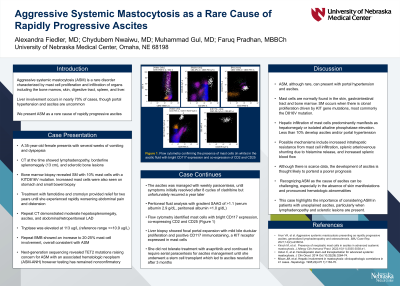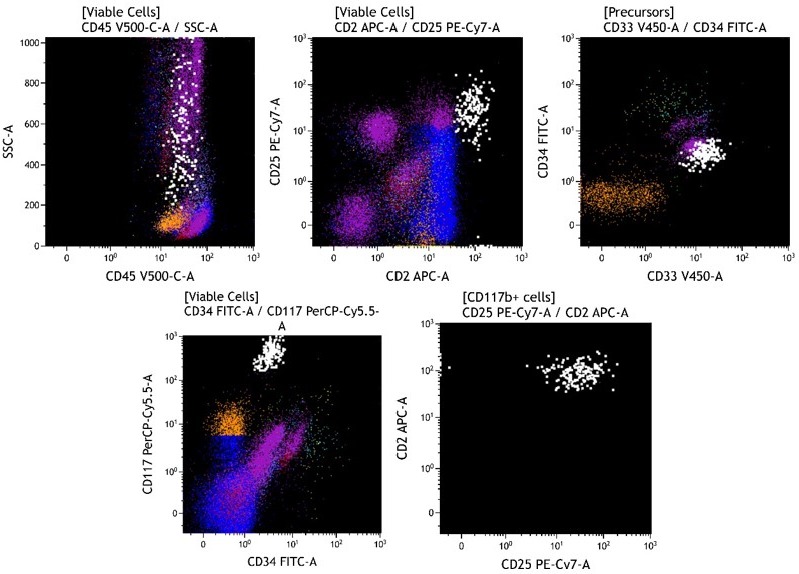Monday Poster Session
Category: Liver
P3099 - Aggressive Systemic Mastocytosis as a Rare Cause of Rapidly Progressive Ascites
Monday, October 28, 2024
10:30 AM - 4:00 PM ET
Location: Exhibit Hall E

Has Audio
.jpg)
Alexandra Fiedler, MD
University of Nebraska Medical Center
Omaha, NE
Presenting Author(s)
Alexandra Fiedler, MD, Chydubem Nwaiwu, MD, Muhammad Gul, MD, Faruq Pradhan, MBBCh
University of Nebraska Medical Center, Omaha, NE
Introduction: Advanced systemic mastocytosis (ASM) is a rare disorder characterized by mast cell proliferation and infiltration in organs such as the bone marrow, skin, digestive tract, spleen, and liver. Liver involvement occurs in nearly 70% of cases, though portal hypertension and ascites are uncommon. We present ASM as a rare cause of rapidly progressive ascites.
Case Description/Methods: A 35-year-old female initially presented with several weeks of vomiting and dyspepsia. Computed tomography (CT) at the time showed lymphadenopathy (LAD), splenomegaly, and sclerotic bone lesions. Bone marrow biopsy (BMB) confirmed systemic mastocytosis with 10% mast cells with KITD816V mutation. Stomach and small bowel biopsies revealed increased mast cells. Symptoms were stable and managed with famotidine and cromolyn until her abdominal pain and distension worsened several years later. Repeat CT noted moderate hepatosplenomegaly, ascites, and abdominal/retroperitoneal LAD. Tryptase was elevated at 113 ug/L (normal ≤ 10.9 ug/L). Repeat BMB showed 20-25% mast cell involvement, consistent with ASM.
The ascites was managed with weekly paracentesis, until symptoms initially resolved after eight cycles of cladribine but unfortunately recurred a year later. Peritoneal fluid analysis was notable for serum ascites albumin gradient (SAAG) of >1.1 (serum albumin 2.9 g/dL, peritoneal albumin < 1.0 g/dL). Flow cytometry identified mast cells with bright CD117 expression, co-expressing CD2 and CD25 (Figure 1). Liver biopsy showed focal portal expansion with mild bile ductular proliferation and positive CD117 immunostaining, a KIT receptor expressed in mast cells. She did not tolerate treatment with avapritinib and continued to require serial paracentesis for ascites management until she underwent a stem cell transplant which led to ascites resolution after 3 months.
Discussion: ASM, although rare, frequently presents as portal hypertension and ascites. Possible mechanisms include increased intrahepatic resistance from mast cell infiltration, splenic arteriovenous shunting due to histamine release, and increased splenic blood flow. Recognizing ASM as the cause of ascites can be challenging, especially in the absence of skin manifestations and pronounced hematologic abnormalities. This case highlights the importance of considering ASM in patients with unexplained ascites, particularly when LAD and sclerotic lesions are present.

Disclosures:
Alexandra Fiedler, MD, Chydubem Nwaiwu, MD, Muhammad Gul, MD, Faruq Pradhan, MBBCh. P3099 - Aggressive Systemic Mastocytosis as a Rare Cause of Rapidly Progressive Ascites, ACG 2024 Annual Scientific Meeting Abstracts. Philadelphia, PA: American College of Gastroenterology.
University of Nebraska Medical Center, Omaha, NE
Introduction: Advanced systemic mastocytosis (ASM) is a rare disorder characterized by mast cell proliferation and infiltration in organs such as the bone marrow, skin, digestive tract, spleen, and liver. Liver involvement occurs in nearly 70% of cases, though portal hypertension and ascites are uncommon. We present ASM as a rare cause of rapidly progressive ascites.
Case Description/Methods: A 35-year-old female initially presented with several weeks of vomiting and dyspepsia. Computed tomography (CT) at the time showed lymphadenopathy (LAD), splenomegaly, and sclerotic bone lesions. Bone marrow biopsy (BMB) confirmed systemic mastocytosis with 10% mast cells with KITD816V mutation. Stomach and small bowel biopsies revealed increased mast cells. Symptoms were stable and managed with famotidine and cromolyn until her abdominal pain and distension worsened several years later. Repeat CT noted moderate hepatosplenomegaly, ascites, and abdominal/retroperitoneal LAD. Tryptase was elevated at 113 ug/L (normal ≤ 10.9 ug/L). Repeat BMB showed 20-25% mast cell involvement, consistent with ASM.
The ascites was managed with weekly paracentesis, until symptoms initially resolved after eight cycles of cladribine but unfortunately recurred a year later. Peritoneal fluid analysis was notable for serum ascites albumin gradient (SAAG) of >1.1 (serum albumin 2.9 g/dL, peritoneal albumin < 1.0 g/dL). Flow cytometry identified mast cells with bright CD117 expression, co-expressing CD2 and CD25 (Figure 1). Liver biopsy showed focal portal expansion with mild bile ductular proliferation and positive CD117 immunostaining, a KIT receptor expressed in mast cells. She did not tolerate treatment with avapritinib and continued to require serial paracentesis for ascites management until she underwent a stem cell transplant which led to ascites resolution after 3 months.
Discussion: ASM, although rare, frequently presents as portal hypertension and ascites. Possible mechanisms include increased intrahepatic resistance from mast cell infiltration, splenic arteriovenous shunting due to histamine release, and increased splenic blood flow. Recognizing ASM as the cause of ascites can be challenging, especially in the absence of skin manifestations and pronounced hematologic abnormalities. This case highlights the importance of considering ASM in patients with unexplained ascites, particularly when LAD and sclerotic lesions are present.

Figure: Figure 1: Flow cytometry confirming the presence of mast cells (in white) in the ascitic fluid with bright CD117 expression and co-expression of CD2 and CD25
Disclosures:
Alexandra Fiedler indicated no relevant financial relationships.
Chydubem Nwaiwu indicated no relevant financial relationships.
Muhammad Gul indicated no relevant financial relationships.
Faruq Pradhan indicated no relevant financial relationships.
Alexandra Fiedler, MD, Chydubem Nwaiwu, MD, Muhammad Gul, MD, Faruq Pradhan, MBBCh. P3099 - Aggressive Systemic Mastocytosis as a Rare Cause of Rapidly Progressive Ascites, ACG 2024 Annual Scientific Meeting Abstracts. Philadelphia, PA: American College of Gastroenterology.
